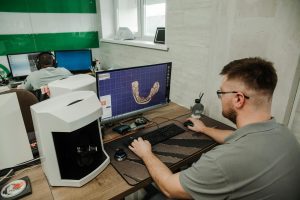In recent years, the field of dentistry has experienced a remarkable evolution due to rapid technological advancements. These innovations have transformed traditional dental practices, introducing new tools and techniques that enhance the efficiency and quality of patient care.
From digital imaging systems to laser treatments, integrating technology in dentistry has opened new avenues for diagnosis, treatment, and preventive care.
Digital Dentistry
Digital dentistry encompasses technological advancements designed to improve dental procedures and patient outcomes. One of the core components is CAD/CAM technology, which allows for the precise design and fabrication of dental restorations such as crowns, bridges, and veneers directly in the office, often within a single visit.
Additionally, digital impressions have replaced traditional methods, offering a more comfortable experience for patients and providing dentists with highly accurate data to create perfect-fitting restorations. Integration of 3D imaging technology facilitates better diagnosis and treatment planning by providing detailed and accurate visualizations of oral structures.
Teledentistry
Teledentistry is revolutionizing the accessibility and delivery of dental care by enabling remote consultations and diagnosis. Patients can connect with dental professionals without needing in-office visits through secure digital communication tools, making dental care more accessible, particularly for individuals in remote or underserved areas.
This approach allows for the convenient sharing of dental images, radiographs, and patient records, facilitating consultations and second opinions.
Laser Dentistry
Laser dentistry is an innovative approach that uses focused light beams to conduct various dental procedures with more precision and less discomfort than traditional methods. Lasers can be employed for hard and soft tissue procedures, ranging from cavity preparation and reshaping gums to advanced treatments such as frenectomy and tissue regeneration.
This technology offers several advantages, including reduced need for anesthesia, minimized bleeding, and faster healing times, making procedures less invasive and more comfortable for patients.
AI and Machine Learning in Dentistry
AI and machine learning are poised to revolutionize the dental industry by enhancing diagnostics and treatment planning accuracy and efficiency.
These cutting-edge technologies can analyze vast amounts of data from medical records, radiographs, and images to identify patterns and anomalies that the human eye might miss. AI algorithms assist in detecting cavities, periodontal diseases, and oral cancers at early stages, facilitating timely intervention and improved patient outcomes.
3D Printing in Dentistry
3D printing is rapidly gaining traction in dentistry, revolutionizing how dental appliances and models are created. This technology enables the efficient and precise production of items such as crowns, bridges, aligners, and surgical guides. Unlike traditional methods, which can be time-consuming and require multiple visits, 3D printing allows for faster turnaround times.
It enhances the ability to provide custom solutions tailored to each patient’s unique oral anatomy. Their expertise ensures dental restorations are accurate, functionally, and aesthetically optimized, highlighting their importance as key oral health care team members. The collaboration between dentists and skilled technicians enhances patient outcomes, improves the fit and comfort of dental devices, and streamlines the workflow for dental professionals, leading to more efficient and satisfactory patient care.
Patient Engagement Technologies
Patient engagement technologies transform how dental practices interact with and involve patients in their care. These technologies include many tools, such as mobile apps, patient portals, and interactive software that offer personalized care plans and educational content.
These platforms allow patients to easily schedule appointments, receive reminders, and access their dental records, enhancing communication and transparency between dental providers and patients.
Integrating innovative technologies in dentistry, like at Precision Family Dental is redefining the landscape of patient care, offering numerous benefits that enhance the quality, accessibility, and effectiveness of dental services.
These advancements are setting new standards in dental practice, from digital tools that provide precise diagnostics and minimally invasive treatment options to advanced patient engagement platforms that foster better provider-patient communication.
As these technologies continue to evolve, they hold the potential to transform the patient experience further, making dental care more personalized, efficient, and accessible to a broader population.
Article provided by Oyster Bay Dentists









A fascinating read! I really appreciate how clearly you explained the impact of 3D printing in dentistry—game changer for both labs and patients.
Great insights into how technology is transforming dental care! The integration of digital tools like CAD/CAM, AI diagnostics, and 3D printing is not only enhancing precision but also improving patient comfort and reducing treatment times. It’s exciting to see how these innovations are making dental visits more efficient and accessible. Looking forward to more advancements in this field!